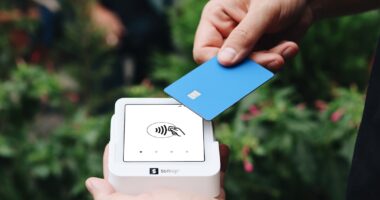Non-fungible tokens (NFTs) are unique digital assets that represent ownership or proof of authenticity of specific items or content, such as artwork, videos, music, or tweets. Unlike fungible cryptocurrencies like Bitcoin or Ethereum, NFTs cannot be exchanged on a one-to-one basis due to their individual uniqueness. NFTs utilize blockchain technology, a decentralized and distributed digital ledger that records transactions across multiple computers.
This technology ensures each NFT’s uniqueness and prevents replication. When created, an NFT receives a unique digital signature verifying its authenticity and ownership, which is stored on the blockchain for public access and transparency. Various online platforms facilitate the buying, selling, and trading of NFTs.
The ownership and transaction history of each NFT can be traced back to its origin, providing transparency and security. This has made NFTs appealing to artists, collectors, and investors interested in digital assets. In essence, NFTs are distinctive digital assets built on blockchain technology, ensuring their uniqueness and security.
Their ability to be traded on online platforms has made them an attractive option for various stakeholders in the digital space.
The Rise of NFT Artists: How to Get Started in the NFT Art World
Getting Started with NFTs
As an artist, getting started in the NFT art world requires a few key steps. First, you’ll need to create a digital wallet to store and manage your NFTs. There are several online platforms that offer digital wallets specifically designed for NFTs, so be sure to do your research and choose one that best suits your needs.
Creating and Minting NFTs
Once you have your digital wallet set up, you can start creating and minting your own NFTs. Minting an NFT involves uploading your digital artwork to a platform that supports NFT creation, such as OpenSea or Rarible, and then adding the necessary metadata and details about your artwork. This process will generate a unique token for your artwork, which can then be bought, sold, and traded on various NFT marketplaces. Keep in mind that there are costs associated with minting NFTs, including gas fees for blockchain transactions, so be sure to factor these into your pricing strategy.
Building Your Presence in the NFT Community
In addition to minting your own NFTs, you can also explore opportunities to collaborate with other artists and creators in the NFT space. Many artists have found success by participating in NFT drops, auctions, and collaborations with other artists, which can help increase visibility and exposure for your work. By staying active and engaged in the NFT community, you can build a following and establish yourself as a reputable artist in the digital art world.
NFT Jobs: Exploring Opportunities in the NFT Market

The growing popularity of NFTs has created a range of new job opportunities in the digital space. From blockchain developers to digital marketers, there are numerous roles available for individuals looking to work in the NFT market. One of the most in-demand roles is that of an NFT curator or art advisor, who is responsible for sourcing and curating digital artwork for NFT platforms and marketplaces.
This role requires a keen eye for emerging talent and an understanding of current trends in the digital art world. Another key role in the NFT market is that of a blockchain developer or smart contract engineer. These individuals are responsible for creating and maintaining the underlying technology that powers NFTs, including the development of smart contracts and decentralized applications (dApps).
As the demand for NFTs continues to grow, so too does the need for skilled developers who can build and optimize blockchain infrastructure for NFT platforms. In addition to these technical roles, there are also opportunities for digital marketers, community managers, and social media strategists to work in the NFT market. These individuals play a crucial role in promoting and selling NFT artwork, as well as engaging with collectors and investors in the online space.
By leveraging their skills in digital marketing and community management, these professionals can help artists and creators maximize their visibility and reach in the NFT market.
Creating Your Own NFT: A Step-by-Step Guide
| Step | Description |
|---|---|
| 1 | Choose a digital asset to tokenize |
| 2 | Create a digital wallet |
| 3 | Select an NFT marketplace |
| 4 | Mint your NFT |
| 5 | List your NFT for sale |
Creating your own NFT is a straightforward process that involves a few key steps. First, you’ll need to choose a platform for minting your NFT. There are several popular platforms that support NFT creation, including OpenSea, Rarible, and Mintable.
Each platform has its own set of features and fees, so be sure to research your options before making a decision. Once you’ve chosen a platform, you’ll need to connect your digital wallet to the platform in order to upload your artwork and create your NFT. Most platforms support popular digital file formats such as JPEG, PNG, GIF, MP4, and WAV, so you can upload a wide range of digital content as an NFT.
After uploading your artwork, you’ll need to add metadata such as title, description, and tags to provide additional context and information about your NFT. Next, you’ll need to set the price and quantity for your NFT. You can choose to sell your NFT as a one-of-a-kind item or create multiple editions with varying prices.
It’s important to consider factors such as rarity, demand, and market trends when setting the price for your NFT. Additionally, you’ll need to factor in gas fees for blockchain transactions when determining the final price for your NFT. Finally, once you’ve completed these steps, you can proceed with minting your NFT on the platform.
This process will generate a unique token for your artwork, which can then be bought, sold, and traded on various NFT marketplaces. By following these steps, you can create and mint your own NFT with ease and start showcasing your digital artwork in the online space.
Selling Your NFT: Tips for Marketing and Pricing Your Digital Art
Selling your NFT requires careful consideration of marketing strategies and pricing tactics to maximize visibility and profitability. One key aspect of selling your NFT is creating a compelling narrative or story around your artwork. By providing context and background information about your piece, you can engage potential buyers and collectors on an emotional level.
This can include details about your creative process, inspiration behind the artwork, or any unique features that make it stand out. In addition to storytelling, it’s important to leverage social media and online communities to promote your NFT artwork. By sharing previews, behind-the-scenes content, and updates about your work-in-progress, you can build anticipation and generate interest in your upcoming NFT drops or auctions.
Engaging with your audience through platforms like Twitter, Discord, or Clubhouse can also help you connect with potential buyers and collectors who are interested in your artwork. When it comes to pricing your NFT, it’s essential to consider factors such as rarity, demand, artist reputation, and market trends. By conducting thorough research on similar artworks and recent sales in the NFT market, you can gain insights into pricing strategies that align with current market conditions.
Additionally, offering incentives such as limited-time discounts or exclusive perks for early buyers can help drive sales and create a sense of urgency among potential collectors. By implementing these marketing and pricing tactics, you can effectively sell your NFT artwork and maximize its visibility and profitability in the online space.
NFT News: Keeping Up with the Latest Trends and Developments in the NFT Space

Following Reputable News Sources
One way to stay updated is by following reputable news sources that cover topics related to blockchain technology, digital art, and the NFT market. Websites such as CoinDesk, Decrypt, The Block, and Cointelegraph provide comprehensive coverage of industry news, market analysis, and emerging trends in the world of NFTs.
Engaging with Online Communities
In addition to news websites, social media platforms like Twitter and Discord are valuable sources of real-time updates and discussions about NFTs. By following industry experts, artists, collectors, and influencers in the NFT space, you can gain insights into upcoming drops, auctions, collaborations, and other relevant events. Engaging with these communities can also help you stay connected with like-minded individuals who share an interest in NFTs.
Attending Virtual Events
Attending virtual events such as webinars, conferences, and panel discussions is another effective way to stay informed about the latest trends in the NFT space. Many organizations host online events that bring together industry leaders and experts to share their knowledge and insights on topics such as blockchain technology, digital art curation, market trends, and investment opportunities in the NFT market. By actively seeking out news sources, engaging with online communities, and attending virtual events, you can stay informed about the latest trends and developments in the NFT space and position yourself for success in this rapidly evolving market.
NFT Platforms: Where to Buy, Sell, and Showcase Your NFT Art
There are several online platforms where artists can buy, sell, showcase their NFT art. OpenSea is one of the largest decentralized marketplaces for NFTs where users can discover a wide range of digital artwork across various categories such as art, domain names, virtual worlds, trading cards, collectibles, sports memorabilia among others. Rarible is another popular platform that allows creators to mint their own tokens without any coding skills required while also offering features like royalties on secondary sales.
Foundation is an invite-only platform known for its curation process where artists submit their work for review by a panel of curators before being accepted onto the platform. KnownOrigin is an artist-focused platform that emphasizes curation quality over quantity while also offering features like limited edition releases which create scarcity value for collectors. SuperRare is another invite-only platform known for its high-quality curation process where artists are carefully selected based on their artistic merit while also offering features like unlockable content which allows creators to add additional layers of content that buyers can unlock after purchase.
In conclusion there are several platforms available where artists can buy sell showcase their nft art each with its own unique features catering to different types of creators making it easier than ever for artists to get started in this burgeoning market.
If you’re interested in learning more about how to create an NFT and sell it, you may want to check out this article on NFT-Jobs.com. The article provides a step-by-step guide on how to create and sell your own NFT, as well as tips for maximizing your sales. You can read the full article here.
FAQs
What is an NFT?
An NFT, or non-fungible token, is a digital asset that represents ownership or proof of authenticity of a unique item or piece of content, such as artwork, music, videos, or collectibles, using blockchain technology.
How do you create an NFT?
To create an NFT, you can use a platform that supports NFT creation, such as OpenSea, Rarible, or Mintable. You will need to upload your digital file, such as an image, video, or audio, and follow the platform’s instructions to mint the NFT, which involves adding details like title, description, and royalties.
How do you sell an NFT?
To sell an NFT, you can list it on an NFT marketplace such as OpenSea, Rarible, or Foundation. You will need to connect your digital wallet, set a price for your NFT, and follow the platform’s instructions to list it for sale. Once listed, potential buyers can make offers or purchase your NFT directly.
What are the costs associated with creating and selling an NFT?
The costs associated with creating and selling an NFT include gas fees for minting the NFT on the blockchain, which can vary depending on network congestion and the platform used. Additionally, NFT marketplaces may charge a fee for listing and selling NFTs, and there may be costs associated with transferring funds from the sale of an NFT.
What are some tips for creating and selling NFTs?
Some tips for creating and selling NFTs include researching the current trends and demand in the NFT market, creating high-quality and unique digital content, promoting your NFT on social media and other platforms, and engaging with the NFT community to build a network of potential buyers and collectors. Additionally, it’s important to consider the environmental impact of NFTs and choose a platform that uses sustainable blockchain technology.




